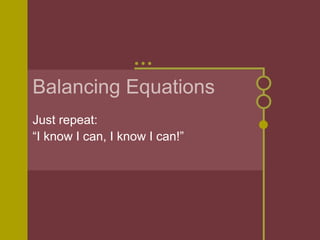
Balancing Equations
- 1. Balancing Equations Just repeat: “I know I can, I know I can!”
- 2. Balancing equations Dueto the conservation of matter, equations MUST be balanced! Atoms cannot be created or destroyed! Thus, the atoms in the products must equal the total atoms in the reactants REMEMBER: The atoms are only being rearranged!
- 3. Coefficients vs. Subscripts Subscripts tell us how many atoms there are in the molecule. O2 This tells us that there are 2 Oxygen atoms bonded to each other: O=O Coefficients tell us how many molecules there are. 2O2 This tells us that there are 2 molecules of O2 O=O and O=O
- 4. How to balance an equation Writeout the equation with the reactants and products formulas MgO + HBr ---> MgBr2 + H2O Magnesium oxide and Hydrogen Bromide becomes Magnesium Bromide and Water.
- 5. How to balance an equation Countthe Atoms of each element on both sides of the equation. MgO + HBr ---> MgBr2 + H2O 1 Mg 1 Mg 1O 1O 1H 2H 1 Br 2 Br
- 6. How to balance an equation Usecoefficients to balance the equation MgO + HBr ---> MgBr2 + H2O We need a total of two hydrogen and bromine on the reactants side in order to balance this equation.
- 7. How to balance an equation Finally…. Our balanced equation MgO + 2HBr ---> MgBr2 + H2O Double check your work, by counting again: 1 Mg 1 Mg 1O 1O 2H 2H 2 Br 2 Br
- 8. Try one on your own! H + O H 2O H- 1 H- 2 O- 1 O- 1 2H + O H2O
- 9. Let’s do another, for fun!! Fe + HCl ---> FeCl2 +H2 1 Fe 1 Fe 1H 2H 1 Cl 2 Cl Fe + 2HCl ---> FeCl2 +H2
- 10. Let’s try a couple more… N2 + O2 ---> N2O5 2N 2N 2O 5O We need to balance out the Oxygen first, then the Nitrogen. This gives us… 2N2 + 5O2 ---> 2N2O5 4N 4N 10 O 10 O
- 11. One More… C2H4 + O2 ---> CO2 + H2O 2C 1C 4H 2H 2O 3O C2H4 + 3O2 ---> 2CO2 + 2H2O